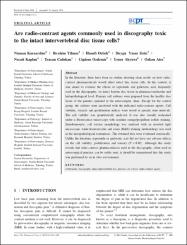| dc.contributor.author | Karaarslan, Numan | |
| dc.contributor.author | Yılmaz, İbrahim | |
| dc.contributor.author | Özbek, Hanefi | |
| dc.contributor.author | Şirin, Duygu Yaşar | |
| dc.contributor.author | Kaplan, Necati | |
| dc.contributor.author | Çalışkan, Tezcan | |
| dc.contributor.author | Ateş, Özkan | |
| dc.date.accessioned | 2022-05-11T14:12:14Z | |
| dc.date.available | 2022-05-11T14:12:14Z | |
| dc.date.issued | 2019 | |
| dc.identifier.issn | 1742-7835 | |
| dc.identifier.issn | 1742-7843 | |
| dc.identifier.uri | https://doi.org/10.1111/bcpt.13112 | |
| dc.identifier.uri | https://hdl.handle.net/20.500.11776/5461 | |
| dc.description.abstract | In the literature, there have been no studies showing clear results on how radio-contrast pharmaceuticals would affect intact disc tissue cells. In this context, it was aimed to evaluate the effects of iopromide and gadoxetic acid, frequently used in the discography, on intact lumbar disc tissue in pharmaco-molecular and histopathological level. Primary cell cultures were prepared from the healthy disc tissue of the patients operated in the neurosurgery clinic. Except for the control group, the cultures were incubated with the indicated radio-contrast agents. Cell viability, toxicity and proliferation indices were tested at specific time intervals. The cell viability was quantitatively analysed. It was also visually rechecked under a fluorescence microscope with acridine orange/propidium iodide staining. Simultaneously, cell surface morphology was analysed with an inverted light microscope, while haematoxylin and eosin (H&E) staining methodology was used in the histopathological evaluations. The obtained data were evaluated statistically. Unlike the literature, iopromide or gadoxetic acid did not have any adverse effects on the cell viability, proliferation and toxicity (P < 0.05). Although this study reveals that radio-contrast pharmaceuticals used in the discography, often used in neurosurgical practice, can be safely used, it should be remembered that this study was performed in an in vitro environment. | en_US |
| dc.language.iso | eng | en_US |
| dc.publisher | Wiley | en_US |
| dc.identifier.doi | 10.1111/bcpt.13112 | |
| dc.rights | info:eu-repo/semantics/openAccess | en_US |
| dc.subject | cytotoxicity | en_US |
| dc.subject | discography | en_US |
| dc.subject | intact intervertebral disc | en_US |
| dc.subject | primary cell culture | en_US |
| dc.subject | radio-contrast agents | en_US |
| dc.subject | High-Intensity Zone | en_US |
| dc.subject | Pain | en_US |
| dc.subject | Proliferation | en_US |
| dc.subject | Stability | en_US |
| dc.subject | Viability | en_US |
| dc.subject | Media | en_US |
| dc.title | Are radio-contrast agents commonly used in discography toxic to the intact intervertebral disc tissue cells? | en_US |
| dc.type | article | en_US |
| dc.relation.ispartof | Basic & Clinical Pharmacology & Toxicology | en_US |
| dc.department | Fakülteler, Tıp Fakültesi, Cerrahi Tıp Bilimleri Bölümü, Beyin ve Sinir Cerrahisi Ana Bilim Dalı | en_US |
| dc.department | Fakülteler, Fen Edebiyat Fakültesi, Biyoloji Bölümü | en_US |
| dc.authorid | 0000-0001-8171-5929 | |
| dc.authorid | 0000-0003-2003-6337 | |
| dc.authorid | 0000-0002-8084-7855 | |
| dc.authorid | 0000-0001-5590-0637 | |
| dc.authorid | 0000-0002-1224-442X | |
| dc.identifier.volume | 124 | en_US |
| dc.identifier.issue | 2 | en_US |
| dc.identifier.startpage | 181 | en_US |
| dc.identifier.endpage | 189 | en_US |
| dc.institutionauthor | Karaarslan, Numan | |
| dc.institutionauthor | Şirin, Duygu Yaşar | |
| dc.institutionauthor | Çalışkan, Tezcan | |
| dc.relation.publicationcategory | Makale - Uluslararası Hakemli Dergi - Kurum Öğretim Elemanı | en_US |
| dc.authorscopusid | 56674583800 | |
| dc.authorscopusid | 35197435300 | |
| dc.authorscopusid | 7005912992 | |
| dc.authorscopusid | 56769801000 | |
| dc.authorscopusid | 57201362754 | |
| dc.authorscopusid | 56674439000 | |
| dc.authorscopusid | 21644315000 | |
| dc.authorwosid | Akyuva, Yener/AAV-5706-2020 | |
| dc.authorwosid | YILMAZ, Ibrahim/H-6199-2019 | |
| dc.authorwosid | Ozbek, Hanefi/O-3472-2019 | |
| dc.authorwosid | sirin, duygu yasar/AAR-8685-2020 | |
| dc.authorwosid | KARAARSLAN, Numan/I-6819-2019 | |
| dc.identifier.wos | WOS:000456596400006 | en_US |
| dc.identifier.scopus | 2-s2.0-85053398131 | en_US |
| dc.identifier.pmid | 30120906 | en_US |



















